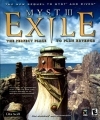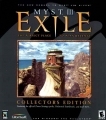Myst III: Exile
First posted on 22 March 2007. Last updated on 15 May 2014.
About the author
Jim Aikin divides his time between music and writing. He's the author of 2 science fiction novels—"Walk the Moons Road" (Del Rey 1985) and "The Wall at the Edge of the World" (Ace 1992), both out of print. He's well known as an expert on electronic music technology; his byline appears regularly in music technology magazines such as Electronic Musician, Keyboard, Mix, and Virtual Instruments. To date he has released 2 text adventure games—"Not Just an Ordinary Ballerina" (1999) and "Last Resort" (2006).
About the game
"Last Resort" is a low-key fantasy horror story—there's almost no actual gore, but some seriously disturbing things may happen to you if you're not careful. You play the part of Diane Lindsay, a 14 year old from New York City who has been dragged off by her aunt to a seedy, rundown motel in rural Mississippi. Before long you'll discover that Diane will be dead before the end of the day unless she's able to escape. The game is large and difficult, and includes numerous characters with whom you can interact.
The initial release of "Last Resort" provoked a thoughtful essay, posted on the newsgroup rec.games.int-fiction, from Interactive Fiction guru Emily Short. In response, the author is now hard at work on a complete revision. Version 2, to be released in the summer of 2007, will be both harder to win (several new puzzles are being added) and harder to lose (the time limits, which can render version 1 unwinnable without notice, are being eliminated). Version 1 has been extensively tested, however, and is fully playable.
For more information on Aikin and "Last Resort" (which is available for download), visit MusicWords: Interactive Fiction.
I'm lousy at solving complicated puzzles. The reason I like adventure games is because they let me poke around in an exotic world, and that's both the bad news and the good news about Myst III: Exile—the worlds to be explored are breathtakingly beautiful, but the puzzles are very, very hard.
Myst III: Exile is loosely a continuation of the storyline begun in Myst and continued in Riven: The Sequel to Myst. The various worlds in the Myst universe are small, self-contained environments surrounded by endless ocean. They were created by a godlike but very human individual named Atrus (played by Myst originator Rand Miller). Atrus creates the worlds—or, as they're styled, "Ages"—by "writing" them in magical books. Magical "linking" books are also the means of transportation between one world and another.
In the introductory cut scene, you meet Atrus, his wife, and their infant daughter. As he's talking to you, a wild-looking individual named Saavedro (deliciously overacted by Brad Dourif) bursts in, sets fire to Atrus's study, and "links" out again using a book. Your job is to pursue him and retrieve the book he has stolen. Apparently it will be a tragedy if you are to fail, but the precise nature of the tragedy is not made very clear.
Your first stop is a rocky island named J'Nanin. Here you'll be taunted by Saavedro in a series of recorded messages—he thinks it's Atrus who is following him, and he has a grudge against Atrus. You'll also, if you're clever, find portals to 3 other Ages—Edanna, Amateria, and Voltaic. The linguistic similarities to Eden and Amaterasu (the Japanese sun goddess) are not hard to spot. The puzzles in Voltaic have to do principally with mechanical power, those in Edanna are biological, and those in Amateria, with its vaguely Oriental rooflines and hanging paper lanterns, are geometrical.
Along the way you'll have to figure out how to repair or work around various bits of sabotage wreaked by Saavedro. If you're observant, you'll pick up numerous pages dropped (accidentally? we can only assume) from his loose-leaf journal. Some of the pages contain important information; others simply fill in the backstory. The character of Saavedro quickly becomes more complex: You begin to suspect that maybe he has a legitimate reason to be enraged at the seemingly benevolent Atrus.
On the other hand, it's hard not to remember Atrus's 2 sons (Achenar and Sirrus) in Myst, who previously made themselves out to be victims but turned out to be evil. The effect of this moral uncertainty is to give you a powerful reason to forge ahead and solve the puzzles. Sadly, in the end it's much ado about nothing. Saavedro is revealed as a scoundrel, but the question of whether his grievance against Atrus is real or imagined is never resolved. To put it bluntly, the game doesn't really tell a story; it's only decorated with the trappings of a story.
The puzzles in the game are of 2 types: Some are purely mechanical and rely on logic or experimentation. The solutions to others depend on your ability to closely observe details of your surroundings. The 2 types are about equally obtuse.
The designs of these Ages combine organic and mechanical elements and textures in appealing ways. Ambient sounds and understated music beds add to the experience. The rippling water effect is gorgeous too, but turning on such effect can be taxing on the computer hardware. Just as impressive as the design is the 3D surround modeling. You can swing almost any view through 360 degrees, and also pan up or down to look at the floor panels and walkways or the ceiling and the sky. If you move to the next location and look back, you'll see the same objects from a different perspective. Faraway objects mostly have jagged edges, but if you just relax and enjoy the scenery, it has almost cinematic breadth. Textures applied to the surfaces of the rocks, doors, and pillars seem solid enough to touch.
Sounds wonderful, doesn't it? Alas, in fact that's part of the problem: There's too much graphic detail. Much of it is just scenery, but here and there what looks like a shadow on a boulder may be a passage to a whole new area. In Voltaic there's a certain passageway along which is a line of similar objects. Most of them are just scenery, but one is an object you need to investigate. It means that you pretty much have to pan around every single location and click on anything that looks even vaguely like it may be significant. This process takes hours, and it's mostly unrewarding. Just panning in a circle won't necessarily do the job: An important object may be down near the floor or up near the ceiling, where you won't see it if you only spin around at eye level.
Mechanical objects are operated by clicking on them. You'll find buttons to press, wheels to turn, and levers to pull. If you do everything right, you may be rewarded by a beautiful (though rather grainy) animated scene. After you step into an elevator, pulling the lever may whisk you up or down (unless it isn't working because the power needs to be restored). For those who have played the original Myst, perhaps I should mention that the elevator motion is now in full screen, not limited to a tiny window.
Whereas the puzzles in Voltaic at least make some kind of bizarre mechanical sense, the puzzles in Amateria appear to be completely arbitrary. An example is the sonic ring puzzle: There are 5 dials, each of which can be set to any of 5 positions, and the solution to the puzzle is to get them all set correctly—after which you have to go to a different location, operate some other controls, and observe the result. Simple arithmetic yields that there are 3125 (5x5x5x5x5) possible ways to set the 5 dials! Yet, there is no clear indication within the game of which settings may be the right ones. This isn't just maddening, it's perverse.
The other puzzles in Amateria are just as difficult (for me, anyhow)—that is, all but impossible. One involves creating a sphere out of sections of different materials, and the other involves putting pegs in holes. Both allow the player hundreds of ways to do it wrong, and there are no in-game hints about how to do it right. With its enormous spheres whizzing around on elevated tracks, Amateria resembles nothing so much as a giant pinball or pachinko machine—very creative, but somehow a bit tacky at the same time.
Getting through Edanna is much of the same process. The paths and scenery in this Age are viscerally organic; at times you're traveling around inside a giant plant. The visual imagery and textures are often close to abstract, and may give no indication whether you're looking up, down, back, forward, or sideways. This makes the process of navigation infuriating. To make matters worse, the steps needed to solve the big puzzle in Edanna are absolutely not clear. Until you reach the end of the process, you'll have no clue why you should bother doing any of the obscure steps along the way.
Strangely, once you've solved the puzzles of all the Ages, the face that appears in the viewer in J'Nanin is no longer Saavedro but Atrus. He speaks about "my sons" which seems quite out of context, as his sons are not characters in this story (though Saavedro talks about them). At this point Atrus sends you off to another Age, called Narayan, where you'll finally confront Saavedro. This is the ending of the story; Narayan isn't large, and there's only one puzzle, which is clever and (for a change) well clued, but also quite complex.
Up to this point the gameplay has been wide open—it hasn't been possible to get killed or stuck in any dead ends. Once you've solved the puzzle in Narayan, however, you'll want to save the game, because there are several branching endings, only one of which is happy.
I purchased Myst III: Exile years ago but had not given it a good try until now. The game refused to run in Windows XP with Service Pack 2 and ran if only Service Pack 1 was installed. This is a sad example of what I'd call "digital rot"—works of art that ought to be timeless, but will soon be completely inaccessible, unless the developer is motivated to bring out an endless stream of new editions. Regardless, I'm glad I finally sat down and finished the game. I wish I could say it was stellar from start to finish, but even with a few lapses it was an unforgettable experience.






